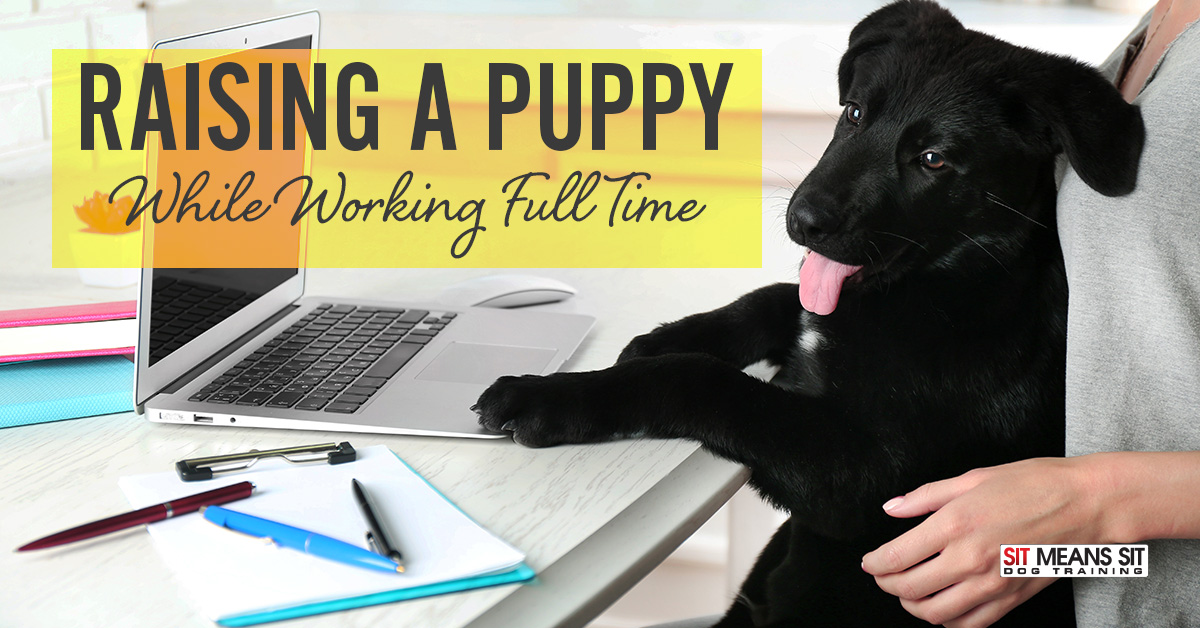
How to Raise a Puppy and Work Full Time
No matter your lifestyle or working situation, bringing a new puppy home is hard work. It takes a lot of time and energy to raise a puppy, and you need to be committed. While it is definitely more of a challenge to raise a new dog or puppy while you’re working full-time, it isn’t impossible. Puppies have a lot of needs, so you need to be able to make adjustments to your lifestyle and routine to successfully raise the new dog. While it can be done, you will need help, whether that be from friends, family, or hiring dog walkers or other professionals– such as our professional dog trainers in Northern Colorado.
How Long Can Puppies Hold Their Pee?
Puppies will vary in the length of time they can hold their pee, but there is a simple equation that can be used.
- First, take your puppy’s age in months and add one. This will give you an idea of how many hours they can hold their bladder.
- For example, a one-month-old puppy can hold their bladder for two hours. A four-month-old puppy can hold their bladder for 5 hours.
Once the puppy reaches 6-7 months you can expect your dog to level off since no dog will be comfortable holding their pee for over an 8-hour period.
How Long Can You Leave Your Puppy Home Alone?
Using the formula mentioned earlier, puppy’s age + 1 = average estimated pee holding time, you can see what is a rough estimate for each pee break period. In the beginning, they will need to go more frequently than other times, but eventually, they will be able to hold on for longer.
During these periods it is important to help create a routine that they can learn in order to be sure that your dog is able to hold their pee when necessary. That way they can plan ahead for their potty times and you can properly potty train your dog. Leaving your dog alone for 8 hours isn’t best for any dog regardless of age so be sure to add periods throughout your day to let them out. Staying consistent is also important so make sure the time chosen works best for most days.
Tips for Raising a Puppy While Working
Tip #1: Leave Your Dog Home Alone
One of the biggest challenges for you and your new puppy will be leaving them at home alone, which is tough for you both. But it is important. If you spend too much time with your pup, they will become dependent and have separation anxiety. You may think it is bad to leave them alone, but it will ultimately benefit them.
The part to be worried about is bathroom breaks. The age of your pup will indicate how long you can leave them alone. Take the puppy’s age in months and add one, and that is the number of hours they can be left without going to the bathroom. As you can probably figure out, you can’t really leave your dog alone at home for a whole workday. You’ll have to either find time in the day to come home and let your dog out or hire help.
Tip #2: Use Your Resources
It is clear your dog will need to be let out during the day. They need breaks whether it is from you or someone your hire to help. You can come home for breaks during the day or ask a friend or neighbor with a different schedule to let your dog out. Other options include hiring a dog walker or dog sitter to come to your home at certain times to let your dog out. With apps like Rover or Wag, it is very easy for you to find reliable people to take care of your pup. Enrolling your pup in some kind of doggie daycare is another option if you can’t find someone during the day, or want an option that may also help train your dog.
Tip #3: Tire Your Dog Out
It is very important your dog still gets everything they need to be happy. You don’t want them to miss out on having a fulfilled life so it’s important to make sure you’re providing them with the proper activities. Before you go to work, make sure they are sufficiently tired. Make sure you take them on a long walk or play fetch. This may require you to wake up early, but it is important to leave your dog tired. You also need to give them things to keep them entertained throughout the day. This means leaving toys and games that will keep them occupied and also get out their energy throughout the day. Some great toys that will keep your dog’s brain working and give your dog entertained while you’re gone during the day are the Kong, Puzzle Toys, and feeder toys.
Obviously, there are other things you need to account for, such as potty training and obedience. But these tips will help you generally have a better start with having a new puppy if you work full time out of the home.
